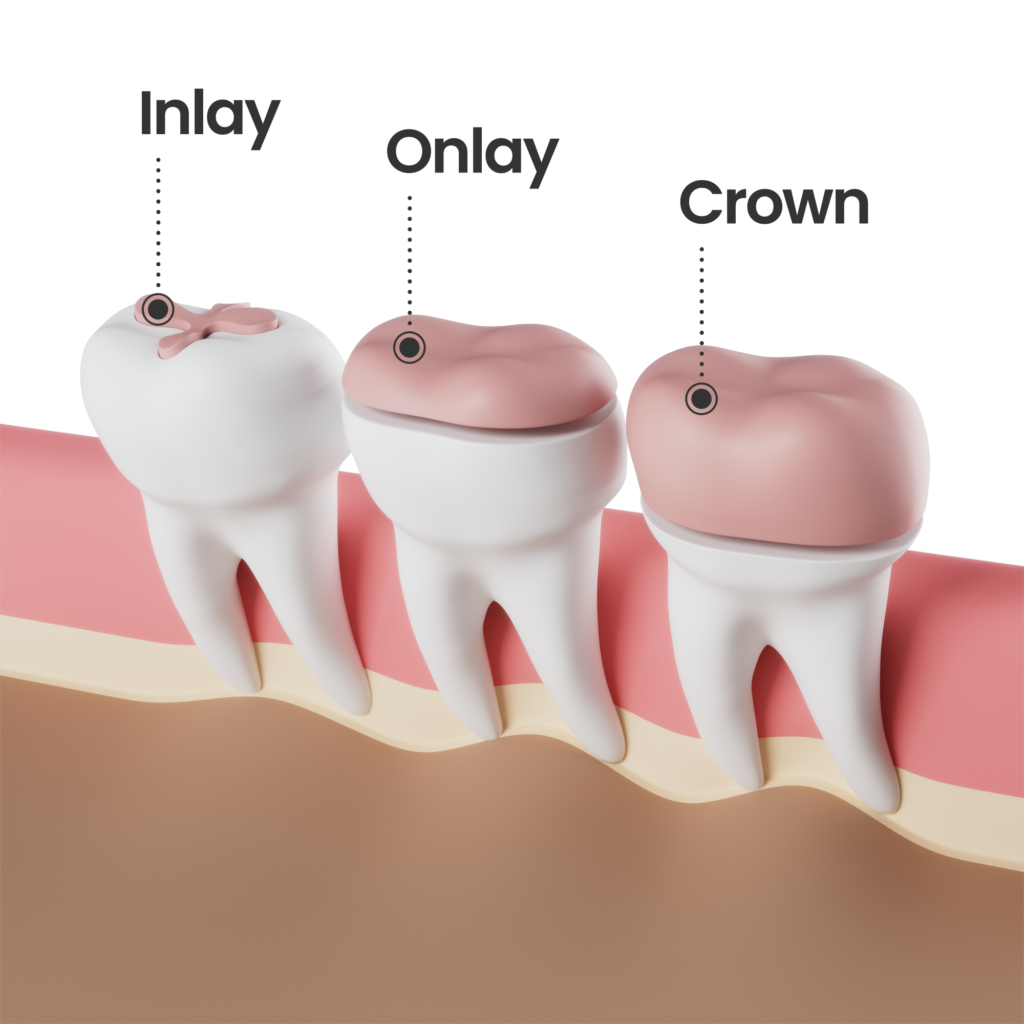Inlays & Onlays
Inlays and onlays are types of indirect dental restorations used to treat mild to moderate tooth decay or damage. They are custom-made in a dental laboratory and bonded to the tooth's surface.
An inlay is a solid filling that fits within the grooves or indented areas of a tooth's chewing surface. An onlay is similar but covers a more extensive area, potentially including one or more cusps (the raised points on a tooth's chewing surface).
Inlays and onlays may be recommended when a tooth has sustained too much damage or decay to be effectively treated with a standard filling. They provide a more substantial and durable restoration than traditional fillings while preserving more of the natural tooth structure than a full crown.
Gallery
Visual insights to help you understand what to expect from your treatment. For more content, please refer to our Education Hub.

Benefits & Considerations
Everything you need to know to make an informed decision about your treatment.
Benefits
Structural Integrity
Inlays and onlays are made from durable materials like composite resin or porcelain, providing long-lasting reinforcement and protection for weakened tooth structure.
Tooth Conservation
Unlike full crowns, inlays and onlays allow for the preservation of more healthy tooth structure, as only the damaged or decayed portions are removed during preparation.
Natural Aesthetics
These restorations can be precisely color-matched and designed to blend seamlessly with your natural tooth enamel, providing a beautiful and virtually undetectable result.
Durability & Longevity
With proper care, inlays and onlays can last for many years, often longer than traditional fillings, making them a cost-effective long-term solution.
Considerations
Tooth Preparation
Some healthy tooth structure must be removed to create space for the inlay or onlay, although this is generally less than what is required for a full crown.
Not For Severe Damage
Inlays and onlays may not be suitable for teeth with extensive damage or decay, in which case a full crown restoration may be necessary.
Relative Cost
These restorations are typically more expensive than traditional fillings due to the specialised materials and laboratory fabrication involved. However, they are still relatively low-cost compared to other permanent restorations.
Treatment Procedure
Let's walk through your treatment procedure from start to finish.
Consultation & Examination
Your dentist will thoroughly examine your tooth and discuss your goals to determine if an inlay or onlay is the most suitable restorative solution. Intraoral scans will be taken to assess the extent of damage or decay.
Tooth Preparation
The area to be treated will be carefully prepared by removing any existing fillings, decay, or damaged tooth structure. The tooth will be shaped to create a precise space for the custom inlay or onlay restoration.
Intraoral Scanning
Using our state-of-the-art intraoral scanner, highly accurate digital impressions of your prepared tooth and surrounding teeth will be captured. These digital scans ensure a precise fit for your custom restoration.
Design & Fabrication
Your inlay or onlay will be designed chairside using advanced CAD/CAM technology. The digital impressions are used to create a virtual design of the restoration, tailored to your unique bite and aesthetic needs. This design is then sent to our in-office milling unit, where your custom inlay or onlay is fabricated from a solid block of high-quality composite resin or porcelain material.
Restoration Placement
Once the custom inlay or onlay is milled to perfection, it will be carefully bonded to your prepared tooth using a strong dental adhesive. Your dentist will ensure a secure and comfortable fit, making any necessary adjustments.
Polishing & Finishing
The final step involves polishing and finishing the restoration to achieve a smooth, natural-looking surface that blends seamlessly with your surrounding teeth. Any minor adjustments to your bite will be made at this time.
Restoration Placement
Once your custom inlay or onlay is ready, it is carefully bonded or cemented into place, ensuring a secure and durable fit.
Post-Operative Care
Simple steps to protect your smile and ensure optimal results in the days following your procedure.
Avoid Hard Foods
In the days following your procedure, avoid biting directly on hard foods, such as ice or hard candy, with the filled tooth to prevent any damage to the new restoration.
Oral Hygiene
Brush twice daily with a soft-bristled toothbrush and fluoride toothpaste. Rinsing with an antiseptic mouthwash can also help reduce plaque buildup.
Regular Check-Ups
Schedule regular dental check-ups and professional cleanings, at least twice a year. Your dentist will monitor the condition of your restoration and perform necessary maintenance to prolong its lifespan.

Inlays and onlays offer a versatile and durable solution for repairing mild to moderate tooth damage or decay. By preserving more of your natural tooth structure and providing a strong, customised restoration, they can help extend the life of your teeth while maintaining a natural appearance. Discuss with your dentist if inlays or onlays are the right restorative option for your unique dental needs.